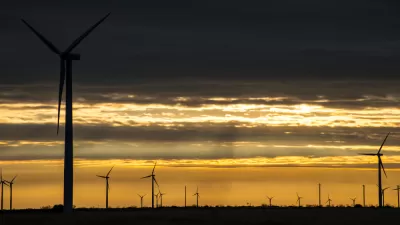Just over a year ago President Obama's draft Clean Power Plan was unveiled. That proposal has been finalized and the president promoted it at a press event on Monday. The final rule is both stronger and more lenient that the original proposal.
"The final rules propose a 32% cut in carbon emissions from power plants by 2030 on 2005 levels, up from the initial proposal of 30%," writes Adam Vaughan, editor of the Guardian's environment site. "However states will only have to comply by 2022 rather than 2020 as originally proposed, and will be able submit their plans on meeting the targets by 2018 instead of 2017."
This rule is aimed at existing power plants and is expected to have the greatest effect on coal-powered plants, though all fossil fuel plants will feel the pinch. Marty Durbin, chief executive of America's Natural Gas Alliance, a trade group representing natural-gas-producing companies, told The Wall Street Journal: "We’re disappointed and discouraged that they [the administration] seem to be ignoring the fact that natural gas has greatly reduced emissions."
Analysts at Sanford C. Bernstein & Co. said the rule would increase utility consumption of natural gas by 7.1 billion cubic feet a day, or 32%, enough to lift national demand for it by about 10%. The big loser—the coal industry—will see consumption drop 23% by 2020, adding to the crisis already rocking mining. Some opponents have labeled the rule a “war on coal.” [Wall Street Journal]
The real winner will be renewables which will get "a head start to wind and solar deployment," according to a White House fact sheet, by driving "more aggressive investment in clean energy technologies than the proposed rule, resulting in 30% more renewable energy generation in 2030 and continuing to lower the costs of renewable energy."
Cap-and-Trade
"A federal model, also expected to be released Monday, would be imposed on the power sectors in states that do not come up with their own plans," writes Alan Neuhauser for US News & World Report. States would be directed toward the two existing programs, the northeast Regional Greenhouse Gas Initiative (RGGI) and the California program.
The model would allow participation in regional cap-and-trade emissions programs, which reward clean-burning power sources by giving them credits they can then sell to heavy polluters.
While push-back that will undoubtedly result much litigation is already coming from coal interests, Vaughan writes that "hundreds of businesses including eBay, Nestle and General Mills have issued their support for Barack Obama’s clean power plan."
FULL STORY: Obama's clean power plan hailed as US's strongest ever climate action

Study: Maui’s Plan to Convert Vacation Rentals to Long-Term Housing Could Cause Nearly $1 Billion Economic Loss
The plan would reduce visitor accommodation by 25% resulting in 1,900 jobs lost.

Alabama: Trump Terminates Settlements for Black Communities Harmed By Raw Sewage
Trump deemed the landmark civil rights agreement “illegal DEI and environmental justice policy.”

Why Should We Subsidize Public Transportation?
Many public transit agencies face financial stress due to rising costs, declining fare revenue, and declining subsidies. Transit advocates must provide a strong business case for increasing public transit funding.

Paris Bike Boom Leads to Steep Drop in Air Pollution
The French city’s air quality has improved dramatically in the past 20 years, coinciding with a growth in cycling.

Why Housing Costs More to Build in California Than in Texas
Hard costs like labor and materials combined with ‘soft’ costs such as permitting make building in the San Francisco Bay Area almost three times as costly as in Texas cities.

San Diego County Sees a Rise in Urban Coyotes
San Diego County experiences a rise in urban coyotes, as sightings become prevalent throughout its urban neighbourhoods and surrounding areas.
Urban Design for Planners 1: Software Tools
This six-course series explores essential urban design concepts using open source software and equips planners with the tools they need to participate fully in the urban design process.
Planning for Universal Design
Learn the tools for implementing Universal Design in planning regulations.
Smith Gee Studio
Alamo Area Metropolitan Planning Organization
City of Santa Clarita
Institute for Housing and Urban Development Studies (IHS)
City of Grandview
Harvard GSD Executive Education
Toledo-Lucas County Plan Commissions
Salt Lake City
NYU Wagner Graduate School of Public Service



























